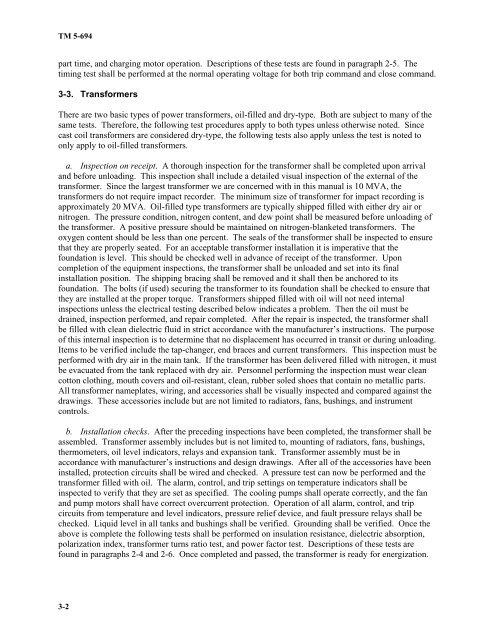Commissioning of Electrical Systems for Command, Control
Commissioning of Electrical Systems for Command, Control
Commissioning of Electrical Systems for Command, Control
You also want an ePaper? Increase the reach of your titles
YUMPU automatically turns print PDFs into web optimized ePapers that Google loves.
TM 5-694<br />
part time, and charging motor operation. Descriptions <strong>of</strong> these tests are found in paragraph 2-5. The<br />
timing test shall be per<strong>for</strong>med at the normal operating voltage <strong>for</strong> both trip command and close command.<br />
3-3. Trans<strong>for</strong>mers<br />
There are two basic types <strong>of</strong> power trans<strong>for</strong>mers, oil-filled and dry-type. Both are subject to many <strong>of</strong> the<br />
same tests. There<strong>for</strong>e, the following test procedures apply to both types unless otherwise noted. Since<br />
cast coil trans<strong>for</strong>mers are considered dry-type, the following tests also apply unless the test is noted to<br />
only apply to oil-filled trans<strong>for</strong>mers.<br />
a. Inspection on receipt. A thorough inspection <strong>for</strong> the trans<strong>for</strong>mer shall be completed upon arrival<br />
and be<strong>for</strong>e unloading. This inspection shall include a detailed visual inspection <strong>of</strong> the external <strong>of</strong> the<br />
trans<strong>for</strong>mer. Since the largest trans<strong>for</strong>mer we are concerned with in this manual is 10 MVA, the<br />
trans<strong>for</strong>mers do not require impact recorder. The minimum size <strong>of</strong> trans<strong>for</strong>mer <strong>for</strong> impact recording is<br />
approximately 20 MVA. Oil-filled type trans<strong>for</strong>mers are typically shipped filled with either dry air or<br />
nitrogen. The pressure condition, nitrogen content, and dew point shall be measured be<strong>for</strong>e unloading <strong>of</strong><br />
the trans<strong>for</strong>mer. A positive pressure should be maintained on nitrogen-blanketed trans<strong>for</strong>mers. The<br />
oxygen content should be less than one percent. The seals <strong>of</strong> the trans<strong>for</strong>mer shall be inspected to ensure<br />
that they are properly seated. For an acceptable trans<strong>for</strong>mer installation it is imperative that the<br />
foundation is level. This should be checked well in advance <strong>of</strong> receipt <strong>of</strong> the trans<strong>for</strong>mer. Upon<br />
completion <strong>of</strong> the equipment inspections, the trans<strong>for</strong>mer shall be unloaded and set into its final<br />
installation position. The shipping bracing shall be removed and it shall then be anchored to its<br />
foundation. The bolts (if used) securing the trans<strong>for</strong>mer to its foundation shall be checked to ensure that<br />
they are installed at the proper torque. Trans<strong>for</strong>mers shipped filled with oil will not need internal<br />
inspections unless the electrical testing described below indicates a problem. Then the oil must be<br />
drained, inspection per<strong>for</strong>med, and repair completed. After the repair is inspected, the trans<strong>for</strong>mer shall<br />
be filled with clean dielectric fluid in strict accordance with the manufacturer’s instructions. The purpose<br />
<strong>of</strong> this internal inspection is to determine that no displacement has occurred in transit or during unloading.<br />
Items to be verified include the tap-changer, end braces and current trans<strong>for</strong>mers. This inspection must be<br />
per<strong>for</strong>med with dry air in the main tank. If the trans<strong>for</strong>mer has been delivered filled with nitrogen, it must<br />
be evacuated from the tank replaced with dry air. Personnel per<strong>for</strong>ming the inspection must wear clean<br />
cotton clothing, mouth covers and oil-resistant, clean, rubber soled shoes that contain no metallic parts.<br />
All trans<strong>for</strong>mer nameplates, wiring, and accessories shall be visually inspected and compared against the<br />
drawings. These accessories include but are not limited to radiators, fans, bushings, and instrument<br />
controls.<br />
b. Installation checks. After the preceding inspections have been completed, the trans<strong>for</strong>mer shall be<br />
assembled. Trans<strong>for</strong>mer assembly includes but is not limited to, mounting <strong>of</strong> radiators, fans, bushings,<br />
thermometers, oil level indicators, relays and expansion tank. Trans<strong>for</strong>mer assembly must be in<br />
accordance with manufacturer’s instructions and design drawings. After all <strong>of</strong> the accessories have been<br />
installed, protection circuits shall be wired and checked. A pressure test can now be per<strong>for</strong>med and the<br />
trans<strong>for</strong>mer filled with oil. The alarm, control, and trip settings on temperature indicators shall be<br />
inspected to verify that they are set as specified. The cooling pumps shall operate correctly, and the fan<br />
and pump motors shall have correct overcurrent protection. Operation <strong>of</strong> all alarm, control, and trip<br />
circuits from temperature and level indicators, pressure relief device, and fault pressure relays shall be<br />
checked. Liquid level in all tanks and bushings shall be verified. Grounding shall be verified. Once the<br />
above is complete the following tests shall be per<strong>for</strong>med on insulation resistance, dielectric absorption,<br />
polarization index, trans<strong>for</strong>mer turns ratio test, and power factor test. Descriptions <strong>of</strong> these tests are<br />
found in paragraphs 2-4 and 2-6. Once completed and passed, the trans<strong>for</strong>mer is ready <strong>for</strong> energization.<br />
3-2
















